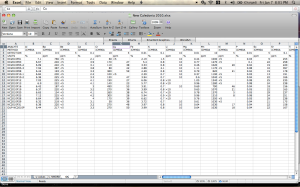
MS Excel (for Mac) spreadsheet with original, unformatted data direct from SGS for the 2010 New Caledonia pumice.
For the past few weeks I have been analyzing the geochemical data from the pumice I collected from New Caledonia over the summer. I had 16 samples analyzed by ICP-AES and ICP-MS by an outside lab, SGS (package ICM90A). The samples were pulverized in chrome steel bowls and dissolved with sodium peroxide fusion. Samples from 2008 were processed the same except they were pulverized in tungsten carbide bowls. The usable geochemical data included the concentrations of 8 major oxides and 31 trace elements. Where available I compiled matching major and trace element data from 16 published papers, for a total of 530 samples including mine (this number is not final).
Many people make the mistake of relying on Excel’s limited (and tedious) graphing functionality for all of their data visualization. Excel is especially poorly equipped to deal with the large amounts of data (over 20,000 fields of data to-date in my comprehensive spreadsheet!) involved in geochemical bivariate analysis. I personally encountered problems with lag and issues with linking the graphed data to the tabulated data. However, Excel has always been a master of data tabulation and with cell-linked formulas it can be quite versatile.
Continue reading